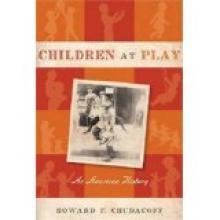
Children At Play is a history of children's play in America from 1600 to the 21st century. Written by Howard P. Chudacoff and published in 2007, it chronicles the play of white children, African American children, and Native American children ages 6 through 12 years old. Chudacoff believes that play is how pre-teen children assert their growing autonomy, and in Children At Play he has given an historical perspective to the “ebb and flow” of their unstructured and structured play. He concludes that “children's ability to play independently has eroded over time and that in the modern era this shrinkage has had unfortunate, if not perilous, consequences.”1
Utilizing children's diaries, autobiographical remembrances, primary source surveys of time usage, census data, child-rearing manuals, the Doll Oral History Collection of The Strong National Museum of Play, toy histories, child literature genres, and published studies of social scientists and journalists, Chudacoff discusses five time periods: early America from1600-1800, new nation building from 1800-1850, play movement beginnings from 1850-1900, the “golden age of unstructured play” from 1900-1950, and commercialization of play beginning 1950 to the present. The twentieth century is a main focus in the book because this is when the “most important and contrasting developments in the history of children's play occurred.”2
For each time period Chudacoff focuses on how children were perceived by adults, what play meant to adults, how children defined play, social conditions, where play took place, play materials, play mates or solo play, and the degree of freedom allowed in play. He also highlights the prevailing philosophies of childhood and play for each time period.
As a general summary, Chudacoff concludes that “there has never been a time of carefree childhood in American history.”3 While this is partly due to the realities of economic and social conditions, it is also due to conflicting purposes of play as seen by adults and preteens. For example, the older generation requires that play be “rational so that it will lead a child to some beneficial end such as wisdom and proficiency.”4 Meanwhile, preteens see play as a way to assert independence from adult constraints. Chudacoff notes that this “nexus between generations, and the resulting contest over the site, materials, participants, and autonomy of children's play, has resulted in both benefits and costs.”5
Over the last 400 years the beliefs concerning the nature of children have shifted from seeing them as “evil” personalities that needed to be “broken,” to basically innocent little persons that needed training, and finally to placing them in the center of the culture as to importance. During this time, the role of childhood and the purposes of play have also shifted with the aid of the prevailing writings of John Locke, Jean-Jacques Rousseau, G. Stanley Hall, Luther Gulick, Sigmund Freud, John and Evelyn Dewey, and Dr. Benjamin Spock. Societal changes, such as the rise of the middle class and mandatory age-structured schools, the shift from sibling play to peer playmates, and the affordability and marketing of manufactured toys, have also affected the types of children's play.
As outlined in Children At Play, acceptable play according to adults has always needed a purpose and a guiding hand. In early America this control was important to avoid idleness, by the 1800s structured play was a means to build a physically and morally strong nation, and in the 1900s play was considered “child's work” for which they needed to be taught how to play correctly in order to prepare them for a successful adulthood. Throughout the centuries there has remained an element of adult oversight, more so among the white and African American cultures than the Native American cultures.6
According to children, play was their own time for amusement, however small or limited it may have been. As Chudacoff explained concerning children's play, “Seeking and protecting autonomy were vital preoccupations of youngsters throughout all eras.” With increasing adult control and supervision, preteens devised a “duality” of play in which they accepted the structured and formal play activities sanctioned by adults while they also fostered “an independent, underground culture of self-devised play” whereby they could fulfill their need for autonomy and creativity.7
Chudacoff concludes with “three basic changes (that) have altered the play of American preadolescents: those involving place, those involving things, and those involving uses of time.”8 Among the “place” changes are the shift from informal, nature based play spaces to formal playgrounds, organized activities, and home-based play. Play “things” have shifted from homemade and improvised toys to the adult sanctioned educational toys and the direct-to-child marketing of manufactured, electronic, and media based entertainment choices. In fact, he states that today the “American culture has linked toys so closely with childhood that in the minds of many people toys define play itself.”9
Time for play was limited in early America due to the realities of their economic existence. With the rise of the middle class and the acceptance of childhood, children were given more time and approval for play. However, in recent years the extension of the school day, the emphasis on academic achievements, and concern for child safety has again limited time for unsupervised and self-directed play.
In conclusion, while Chudacoff acknowledges that preteen children stand “with one foot in childhood and the other planted in the adult world,” he suggests that “we should consider how and when to give kids more independence to explore their environment, create playthings, interact with other kids, and simply enjoy being young.”10

